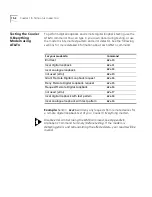
Configuring the Courier V.Everything Modem for Leased Line Operation
16-3
Configuring the
Courier
V.Everything
Modem for Leased
Line Operation
You can use the Courier V.Everything modem in either smart or dumb
mode (determined by the position of DIP switch 8).
If you are using your modem on a leased or dedicated line, it is set to
&L1, and the remote modem has a comparable setting, the modems
automatically connect when they are powered on. They also reconnect,
without any operator intervention, if a disturbance on the line is severe
enough to break the connection.
1
Set your terminal or communications software to the rate at which you
want the modems to communicate.
For example, use a terminal/software setting of 9600 bps and, if both
modems have the capability, they will connect at 9600 bps.
2
Send
AT&B1&S2&H1&L1&W
to the modem
.
We recommend using the &S2 setting to delay CTS until after the
connection is made, as a precaution.
If the modems are in the process of connecting or reconnecting, the
Courier V.Everything modem interprets any keyboard data entry,
including an accidental key stroke, as a key-press abort, and hangs up.
Delaying CTS until after carrier detection prevents this from happening.
However, you have to set the Courier V.Everything modem for hardware
flow control by sending
AT&H1
.
If your software or machine does not support Clear to Send (CTS), don't
include &S2 and &H1 in the command string as suggested above. But
keep in mind that if the modems fail to connect or reconnect, the reason
could be a keypress abort.
&B1
Fixes the Courier V.Everything modem's serial port
rate at the same rate you selected when setting up
your communications software.
&S2
Causes the Courier V.Everything modem to send a
Clear to Send (CTS) signal only after it sends the
Carrier Detect (CD) signal, that is, only after it
connects with the remote modem.
&H1
Enables hardware (CTS) flow control.
&L1
Forces the modems off hook at power on and
enables them to re-establish the connection should
it be broken (for leased lines only).
&W
Writes the settings to nonvolatile memory
(NVRAM) as power-on defaults.
Summary of Contents for Courier
Page 12: ......
Page 28: ...1 14 CHAPTER 1 CONNECTING TO YOUR ISP ...
Page 36: ...3 4 CHAPTER 3 UPGRADING YOUR MODEM ...
Page 58: ...6 6 CHAPTER 6 WORKING WITH MEMORY ...
Page 64: ...8 4 CHAPTER 8 CONTROLLING EIA 232 SIGNALING ...
Page 72: ...9 8 CHAPTER 9 ACCESSING AND CONFIGURING THE COURIER V EVERYTHING MODEM REMOTELY ...
Page 80: ...10 8 CHAPTER 10 CONTROLLING DATA RATES ...
Page 96: ...12 6 CHAPTER 12 FLOW CONTROL ...
Page 108: ...13 12 CHAPTER 13 HANDSHAKING ERROR CONTROL DATA COMPRESSION AND THROUGHPUT ...
Page 112: ...14 4 CHAPTER 14 DISPLAYING QUERYING AND HELP SCREENS ...
Page 122: ...15 10 CHAPTER 15 TESTING THE CONNECTION ...
Page 142: ...17 8 CHAPTER 17 TROUBLESHOOTING ...
Page 156: ...A 14 APPENDIX A S REGISTERS ...
Page 172: ...B 16 APPENDIX B ALPHABETIC COMMAND SUMMARY ...
Page 178: ...C 6 APPENDIX C FLOW CONTROL TEMPLATE ...
Page 186: ...E 4 APPENDIX E V 25 BIS REFERENCE ...
















































